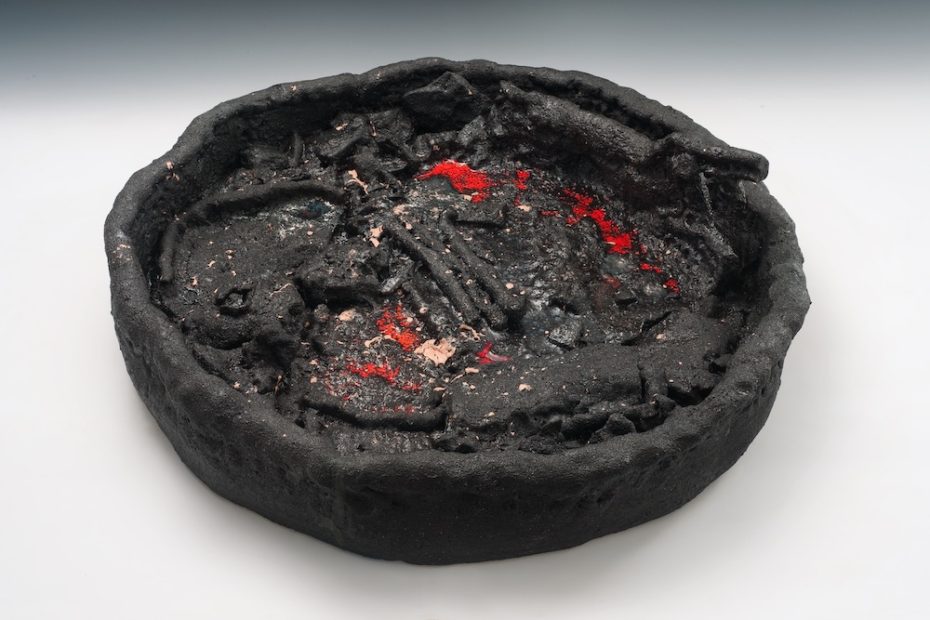This week, we feature a bilingual Friday Art Note, written and recorded in Spanish and English.
When I first saw Sterling Ruby’s Basin Theology/La Brea 2, its disharmonious appearance prevented me from engaging with it further. But after a second look and learning some background, my feelings towards this piece changed.
It turns out that La Brea is considered one of the most important paleontological sites in the world due to the quantity and variety of fossils found there. This unusual site, located in urban Los Angeles, was once a tar pit and worked as a sort of time capsule, preserving an entire ecosystem for over 50,000 years. Findings range from big mammals such as mammoths or small animals such as rodents to plant remains.
When I became aware of this history, and the fact that Ruby’s Basin Theology/La Brea 2 is filled with the remnants of previous ceramic work attempts which he calls Basin Theology, I had a newfound interest in the piece. Indeed, basin theology makes reference to the basin that Jesus used to wash the feet of the apostles during the last supper. In addition, Ruby’s studio can be conceived as an artistic paleontological site as well, because he keeps all his previous work scraps for long periods of time, looking for just the right moment to reuse them in future works.
All this information gave me a different perspective with which to look at this piece and be able to engage with it. Basin Theology/La Brea 2 makes me think of a tar pit with its predominantly black color and harsh texture. I can imagine myself as a paleontologist, digging into what was formerly a geological time capsule, and finding Ruby’s previous ceramic work attempts. I feel they have a story about the process of making art. They are not futile efforts anymore; instead they remain timeless like fossils and hold new meaning and purpose in the basin. At the same time, the bright red and orange bring me the sensation of a still active site waiting to trap you.
Sergio Salicio is a visitor assistant from Barcelona, Spain. He holds degrees in sociology and social studies education. He is passionate about how history, sociocultural issues, and politics influence and shape the artistic world.
Cuando vi por primera vez Basin Theology/La Brea 2 de Sterling Ruby, su apariencia desarmonizada me impidió conectar con ella. Pero después de observarla con detenimiento por segunda vez y darle contexto, mis sentimientos hacia esta obra cambiaron.
La Brea está considerado uno de los yacimientos paleontológicos más importantes del mundo debido a la cantidad y variedad de fósiles localizados. Esta inusual ubicación, en la urbana Los Angeles, era un pozo de alquitrán y se le considera una especie de cápsula del tiempo, ya que preserva un ecosistema completo durante un periodo de más de 50,000 años. Los hallazgos arqueológicos van desde grandes mamíferos como mamuts o pequeños animales como roedores a restos de plantas.
Cuando conocí la historia y el hecho de que Basin Theology/La Brea 2 tiene restos de previos trabajos de cerámica a la que él llama Basin Theology, tuve un renovado interés por la obra . De hecho, Basin Theology hace referencia a la vasija que Jesús utilizó para lavar los pies a sus apóstoles durante la última cena. Además, el estudio de Ruby puede concebirse como un lugar artístico pero también paleontológico pues mantiene todos los restos de trabajos previos que salieron mal durante largos períodos de tiempo hasta encontrar el momento adecuado para reutilizarlos en nuevos proyectos artísticos.
Toda esta información me dio una perspectiva diferente con la que mirar esta pieza y poder así conectar con ella. Basin Theology/La Brea 2 me hace pensar en una cápsula del tiempo en forma de pozo de alquitrán por su color predominantemente negro y textura ruda. Me imagino a mí mismo como paleontólogo, investigando el pozo y descubriendo los trozos de cerámica de sus descartes. Siento que estas piezas transmiten una historia sobre el proceso de crear arte. Ya no son restos inútiles, sino que permanecen atemporales como los fósiles y tienen un nuevo significado y propósito en la vasija. Al mismo tiempo, estos colores brillantes rojos y naranjas me dan la sensación de un lugar aún activo esperando para atraparte.
Sergio Salicio es originario de Barcelona, España y trabaja como asistente del visitante en el ICA. Tiene estudios superiores en sociología y educación, en la especialidad de ciencias sociales. Le apasiona la historia, los eventos sociales y la política, y como todos ellos influencian y dan forma al mundo artístico.
Friday Art Notes are personal reflections on works of art shown or in the permanent collection of the ICA, written by ICA staff, volunteers, and supporters. Read more
